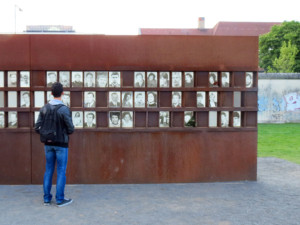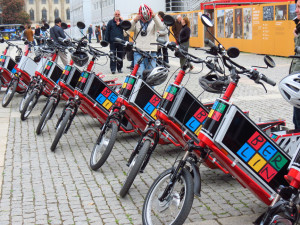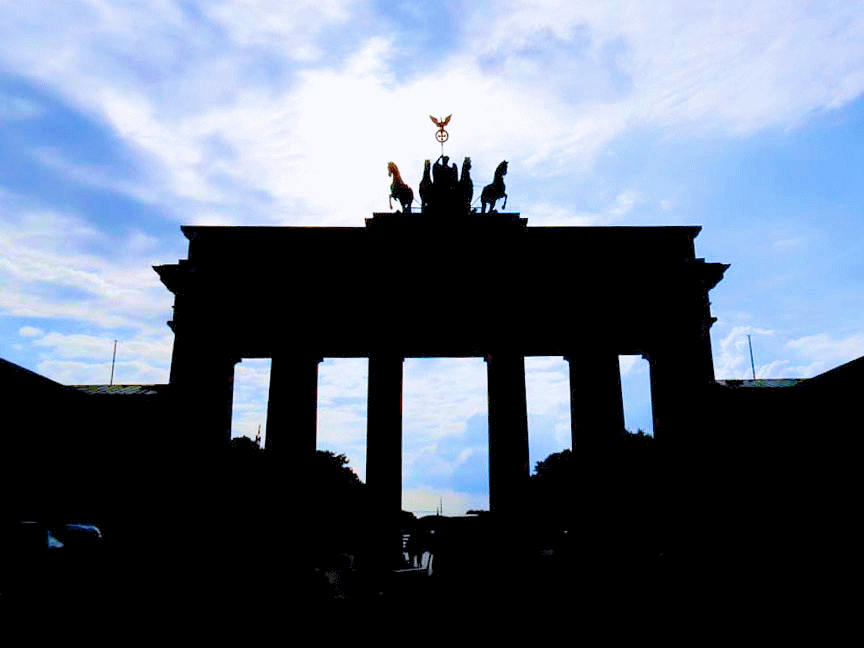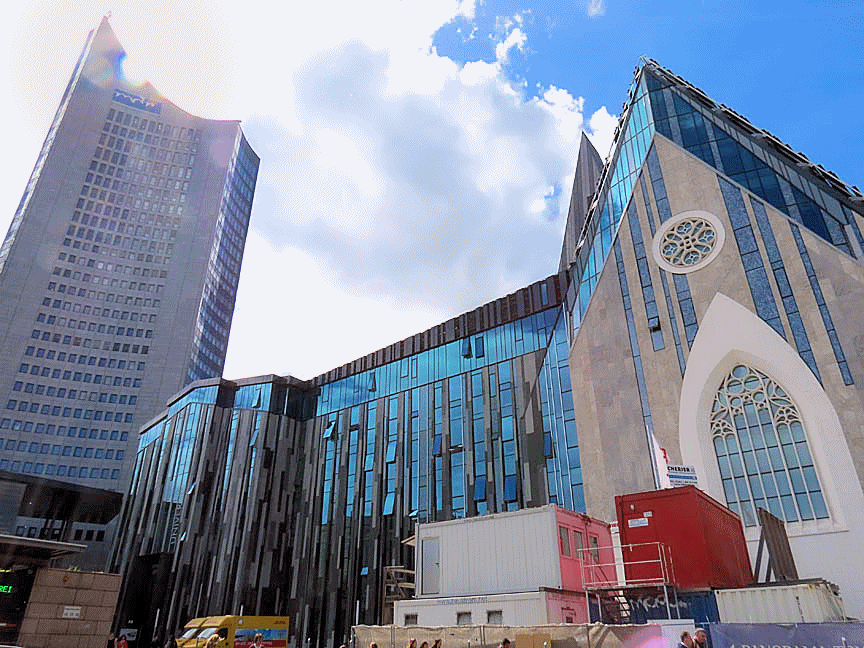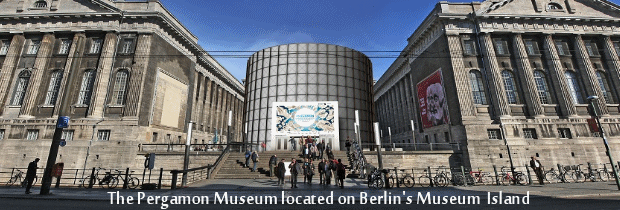
When the Berlin Wall came down in 1989, a party began that is gaining momentum this year as Berlin, once again the capital of Germany, and Leipzig, which was instrumental in the fall of the Wall, celebrate 25 years of national unity.
Work on the 97-mile long Berlin Wall began August 13, 1961, and was reinforced nearly continuously until its breaching. Throughout its 38-year existence the concrete and barbed wire border between West and East Berlin came to symbolize the Cold War and was the epicenter of East-West confrontations.
Opposition to the Wall heated up in earnest in Leipzig in October 1989 when Monday demonstrators, proclaiming “We are the people,“ spurred the so-called “Peaceful Revolution.” Protests quickly spread to other East German cities and Berlin. On November 9, the East German government approved a new travel law, giving citizens a permanent right to travel. That evening, the border at Berlin Wall was opened, and the rest is history.
In addition to the Day of German National Unity, now celebrated annually on October 3, Berlin and Leipzig are commemorating 25 years of reunification this year. Travelers may especially be interested in the following:
Special Events in Berlin
The Berlin Wall Memorial, containing the last section of the Berlin Wall that still stands and provides a sense of its foreboding presence.
The newly renovated Berlin Wall Documentation Centre, set to re-open in time for celebrations on November 9, will feature a new permanent exhibition tracing the Wall’s history.
A seven-mile long installation across the city on November 7 – 9 will feature thousands of illuminated, helium filled balloons. On November 9 people will join hands to form a human chain running parallel to the lights.
The Museum in the Kulturbrauerei (a former brewery), which opened last fall, features a permanent exhibit depicting everyday life in the former German Democratic Republic, providing a vivid reminder of how an all-powerful dictatorship oppresses much of daily life.
The highly popular Checkpoint Charlie Museum documents the well-known border crossing point between U.S. and the former Soviet forces.
The Spy Museum Berlin, due to open in July, will showcase Cold War espionage and secret services in Berlin.
Commemorative Events in Leipzig
A Festival of Lights on October 9, featuring light installations, art exhibits, concerts, and live performances, will commemorate the Peaceful Revolution.
The St. Nicholas Church, where peaceful demonstrations helped pave the way to freedom and reunification, will host a light installation by the artist Tilo Schulz to honor the role Leipzig’s citizens played in 1989.
The Stasi Museum in the former headquarters of the East German secret police, features a permanent exhibition on ‘STASI – Power and Banality.”
The Forum of Contemporary History Leipzig traces the history of division, resistance, and unification.
See Berlin ‘Round the Clock
Berlin, the third most popular European tourist destination after London and Paris, is a 24-hour-a-day city that has so much to offer that a brief visit only scratches the surface and leaves even the most experienced traveler eager for more.
Located on the Spree river, Berlin dates to the 12th century and boasts more bridges—960 in total—than Venice, a legacy of its membership in the Hanseatic League, an organization of German towns along and near the Baltic Sea that sought to protect trade during the 13th to 17th centuries.
Home to 3.3 million people, Berlin has:
- Art, old and new, conservative and daring. Nearly 450 galleries and 180 museums and collections, ranging from the Pergamon Museum with artifacts dating back 6000 years to the Currywurst Museum, which celebrates Berlin’s twentieth-century contribution to fast food.
- Entertainment that won’t stop. Every day, one can choose from a staggering 1,500 cultural events performed on 150 stages and elsewhere, including three opera houses and eight symphony orchestras. If that’s not enough, take your pick of 130 cinemas.
- Food catering to all tastes and budgets. Be it street food or the 14 restaurants boasting Michelin stars, Asian, vegan, or traditional German roast pork and potato dumplings, the cuisine of Berlin makes it the country’s gourmet capital. Check out the Zagreus Projekt, a unique restaurant that combines food and art; the owner commissions new wall art every two months that depicts the food being served.
- Architecture that dazzles – from the Fernsehturm (TV tower) in Alexanderplatz, one of Europe’s tallest structures at 1,200 feet, to the sparkling glass tower atop the Reichstag (Parliament), to the spanking new Potsdamer Platz full of bold glass and steel buildings, to the neoclassical Gendarmenmarkt square.
- Shopping, ranging from KaDeWe, the largest department store in Europe, and other big complexes to boutiques and trendy stores along Kurfürstendamm and throughout the Mitte district.
World-class public transportation in the form of buses, trams, and subways makes getting around Berlin easy, made simpler still with the Berlin WelcomeCard pass, good for up to five days including discounts to cultural sites. Now being introduced are E-Trikes, a three-wheeled electric mode of personal transportation that lets you zoom around the city at up to 15 miles per hour. It’s a fun, safe way to cover a lot of territory quickly.
As in any city, walking connects you with its heart and pulse, and Berlin is a walker’s delight. A good walking introduction to central Berlin will take you up the Kurfürstendamm, known locally as the Ku’damm, to the Kaiser-Wilhelm Memorial Church, one of the city’s best known landmarks, which has been maintained in its partially destroyed state from World War II to commemorate peace and reconciliation.
Then continue along or through the 500-acre Tiergarten park in the city’s center, to the Brandenburg Gate, the last of the city’s 18 original gates and perhaps the most recognized icon of the formerly divided city. This is where in 1987 Ronald Reagan told his Soviet counterpart, Mikhail Gorbachev, to “tear down this wall.”
On the other side of the gate, is the city’s stately main boulevard, Unter den Linden, named for the linden trees that line it. This will lead you to Museum Island, home to five major museums, so significant that the island has been declared a UNESCO World Heritage site. The Pergamon Museum, the city’s most visited, displays the world-famous Pergamon Altar, the legendary, 3,300 year-old limestone bust of Nefertiti, and the ceramic lion-emblazoned Ishtar Gate of Babylon built by King Nebuchadnezzar II.
For a completely different change of scene, head next to the nearby Hackescher Markt, a popular destination for shopping, café sitting, dining, and strolling – by veteran city dwellers and first-time visitors alike.
Hotel accommodations in Berlin span the full range, from budget to five-star luxury. The Maritim Hotel Berlin on Stauffenbergstrasse near Embassy Row, with more than 500 rooms and full amenities, offers a convenient location for touring the city’s center.
Getting Acquainted with Leipzig
With one-seventh the population of Berlin, and only 70 minutes away by train or two hours by car, Leipzig offers an appealing contrast to its larger neighbor, but is nonetheless a dynamic, international city filled with history, music, art, commerce, and tourism.
The people of Leipzig are proud of their pivotal role in ending the Cold War and eager to share it. But that is only the tip of the iceberg. In 2015, the city will celebrate the thousandth year since “Leipzig” was first mentioned, and the world is invited.
Leipzig is a city of musical and modern history and the two intersected at the St. Nicholas Church. That’s, where Bach’s St. John Passion premiered in 1724 and where weekly peaceful demonstrations in 1989 inspired similar protests in Berlin that led to the fall of the Wall.
Having been a crossroads of international commerce for eight centuries, due to its central location, Leipzig reestablished itself economically after reunification. Since 1989, Porsche, BMW, Dell Computer, and Amazon.com have invested significantly in the city. Today, Leipzig continues as an important site for conventions and trade fairs, most notably the The Leipzig Trade Fair, which dates back nearly a thousand years.
Being small in scale—the city center is only one-half square kilometer in size—Leipzig is easily traversed by foot.
A five-kilometer Music Trail links 23 significant sites of the musical history of Leipzig, which was home to Johann Sebastian Bach and where the world-renown Gewandhaus Orchestra, founded in 1743, still plays. It’s where Richard Wagner was born and where Felix Mendelssohn founded the first German conservatory. The recently reopened Mendelssohn House museum, where the composer worked and died, includes his piano and provides a sense of the man and his times.
Leipzig has an active nightlife beyond formal concerts and musical events. The Barfussgaesschen (Bare Foot Alley) area near the old city hall is full of lively outdoor bars and restaurants, good food and drink—be sure to try Leipziger Gose beer—and the welcoming, freedom loving people of Leipzig.
The Steigenberger Grandhotel Handelshof is superbly situated in the middle of town, providing easy access to all sites.
Leipzig Tourismus und Marketing GmbH, www.leipzig.travel
Visit Berlin, www.visitberlin.com


